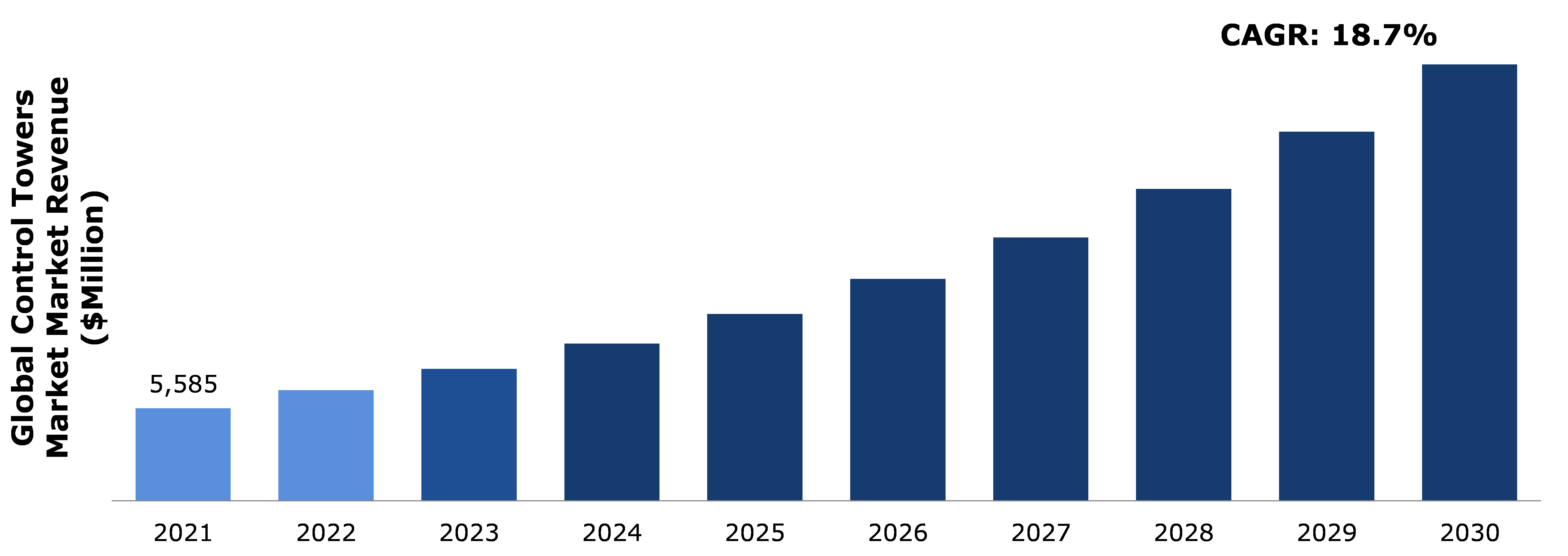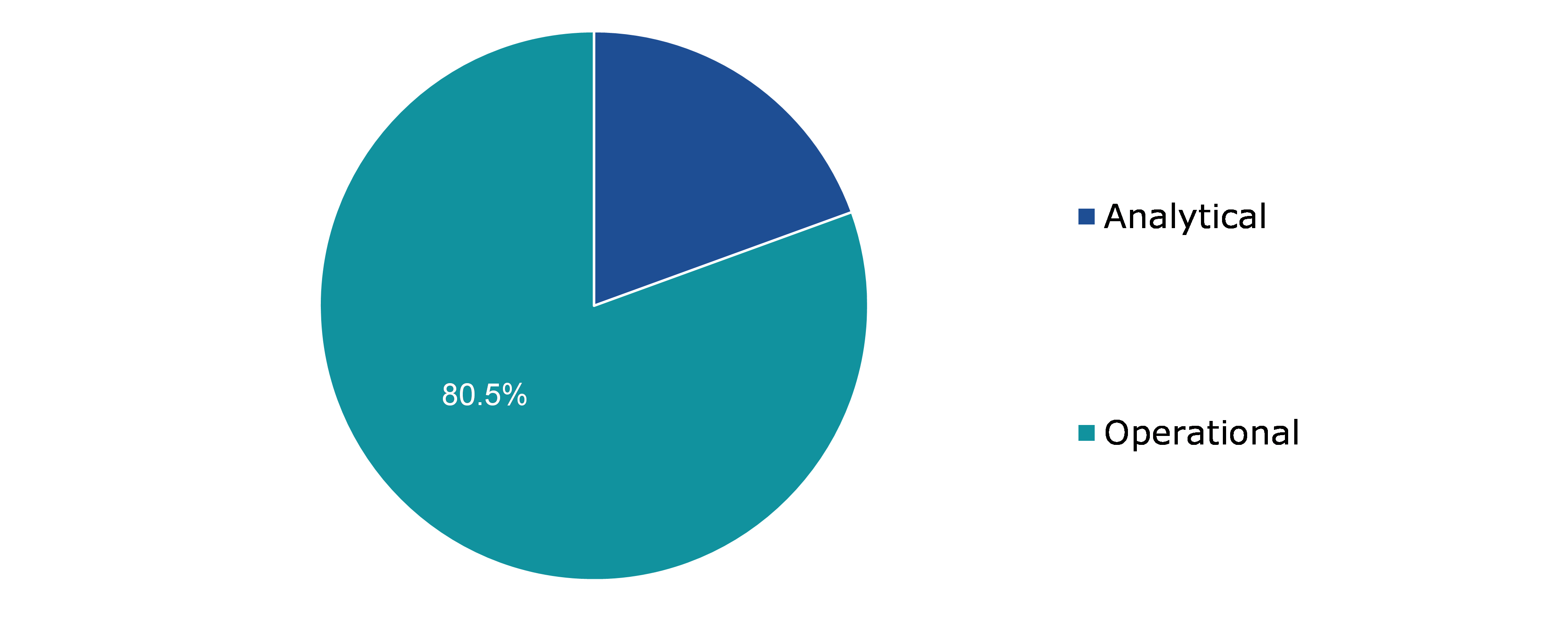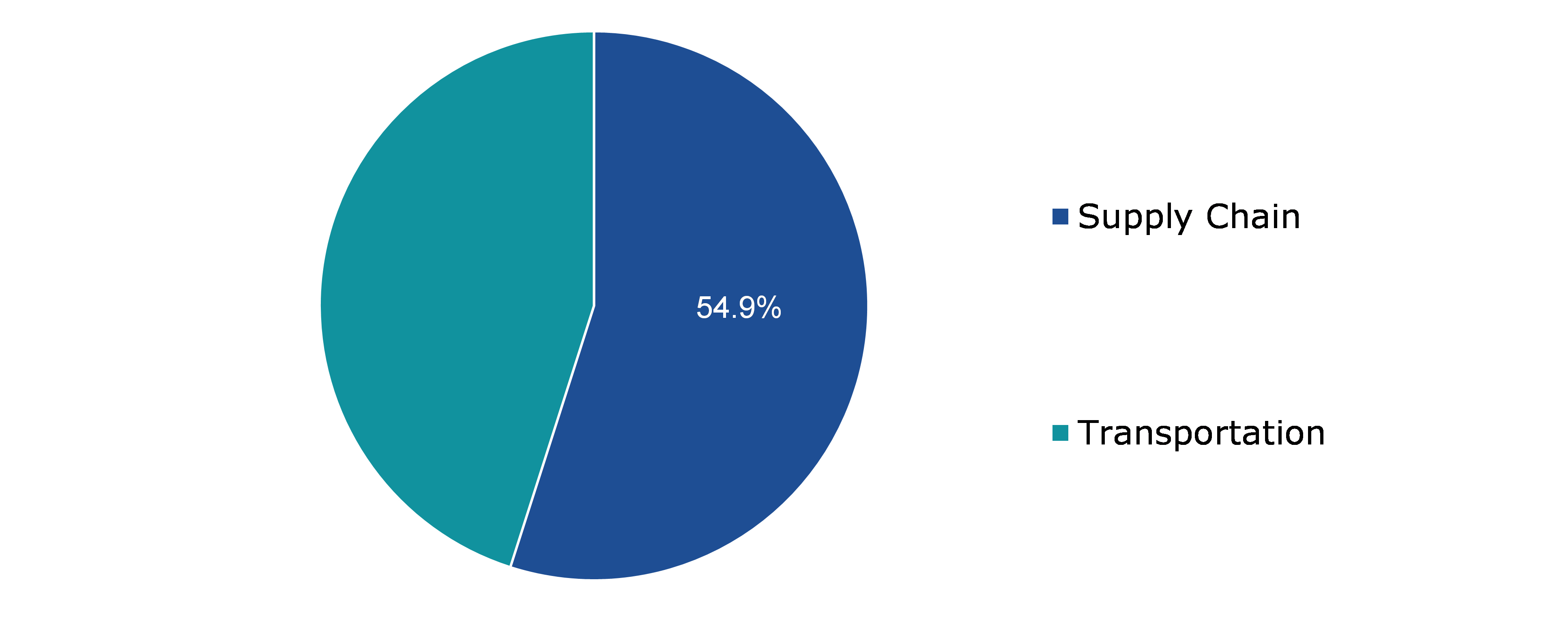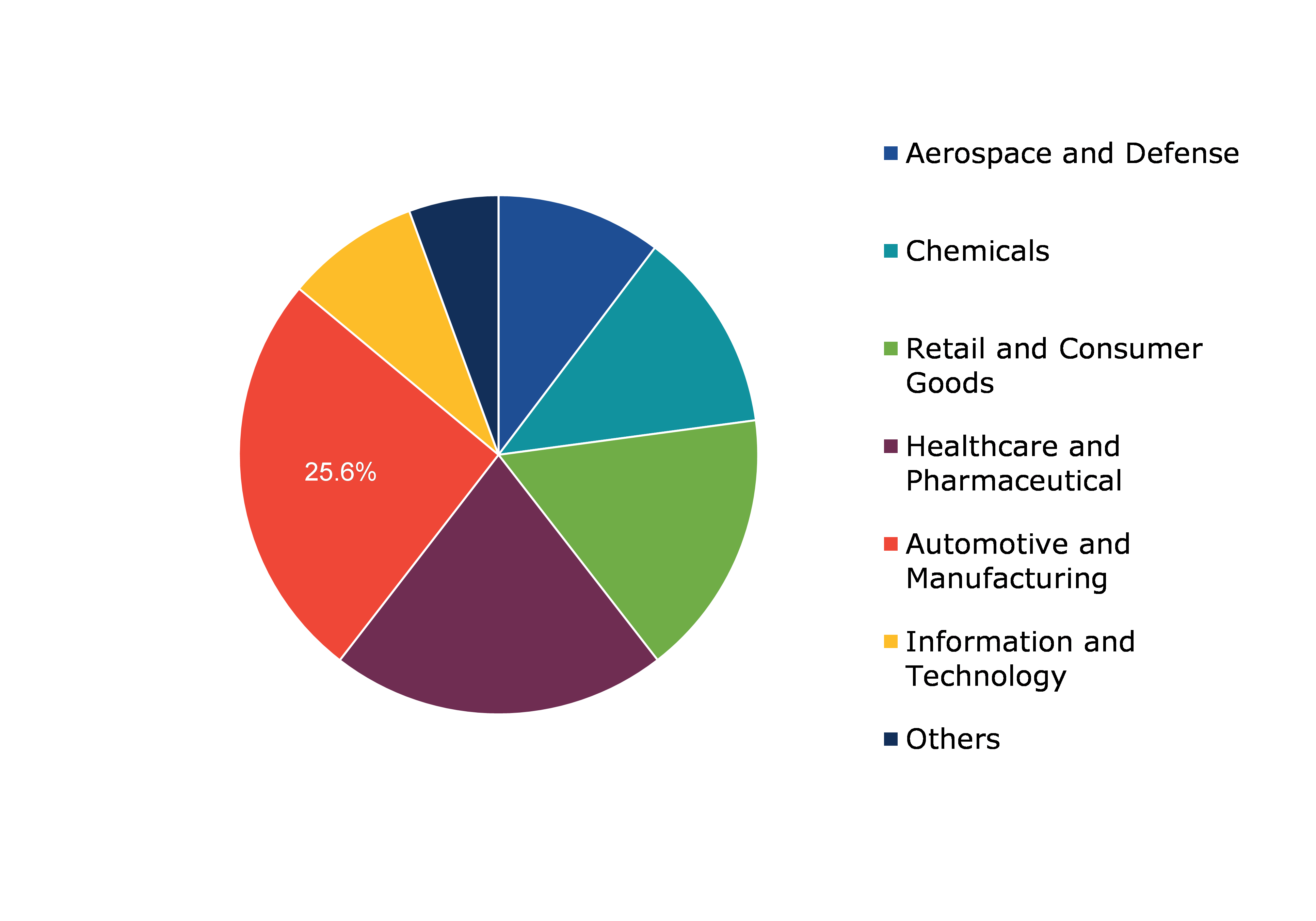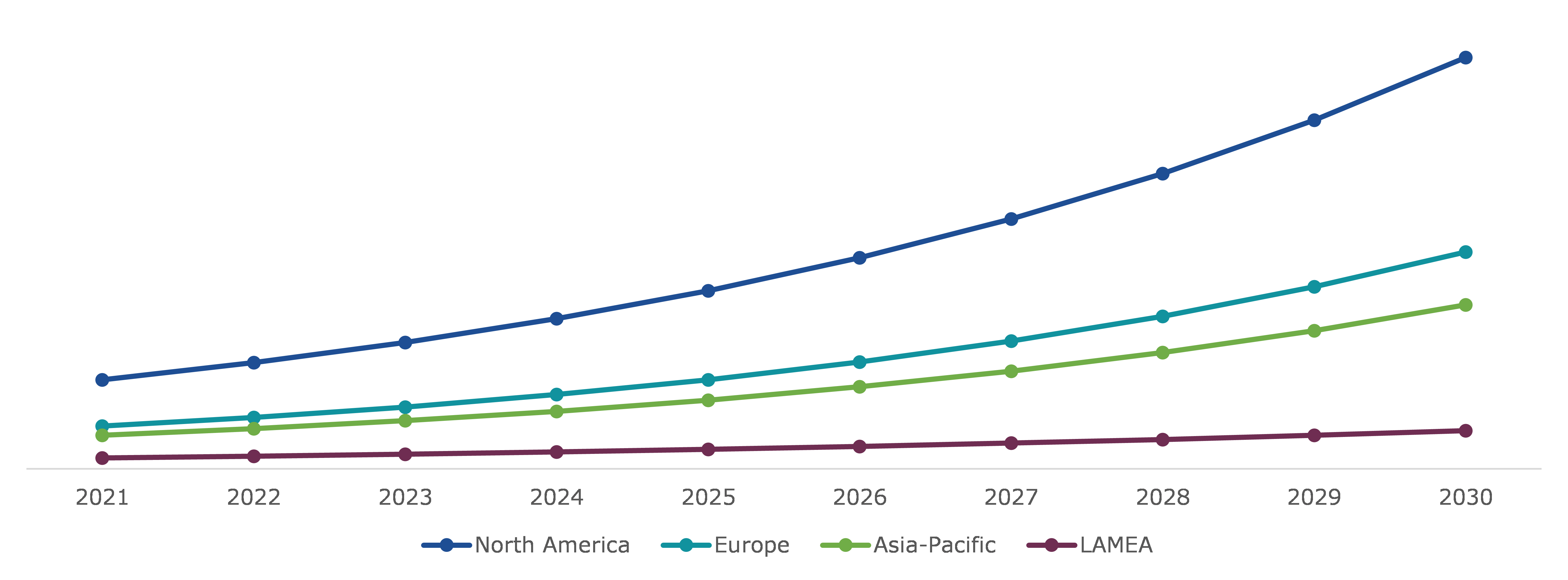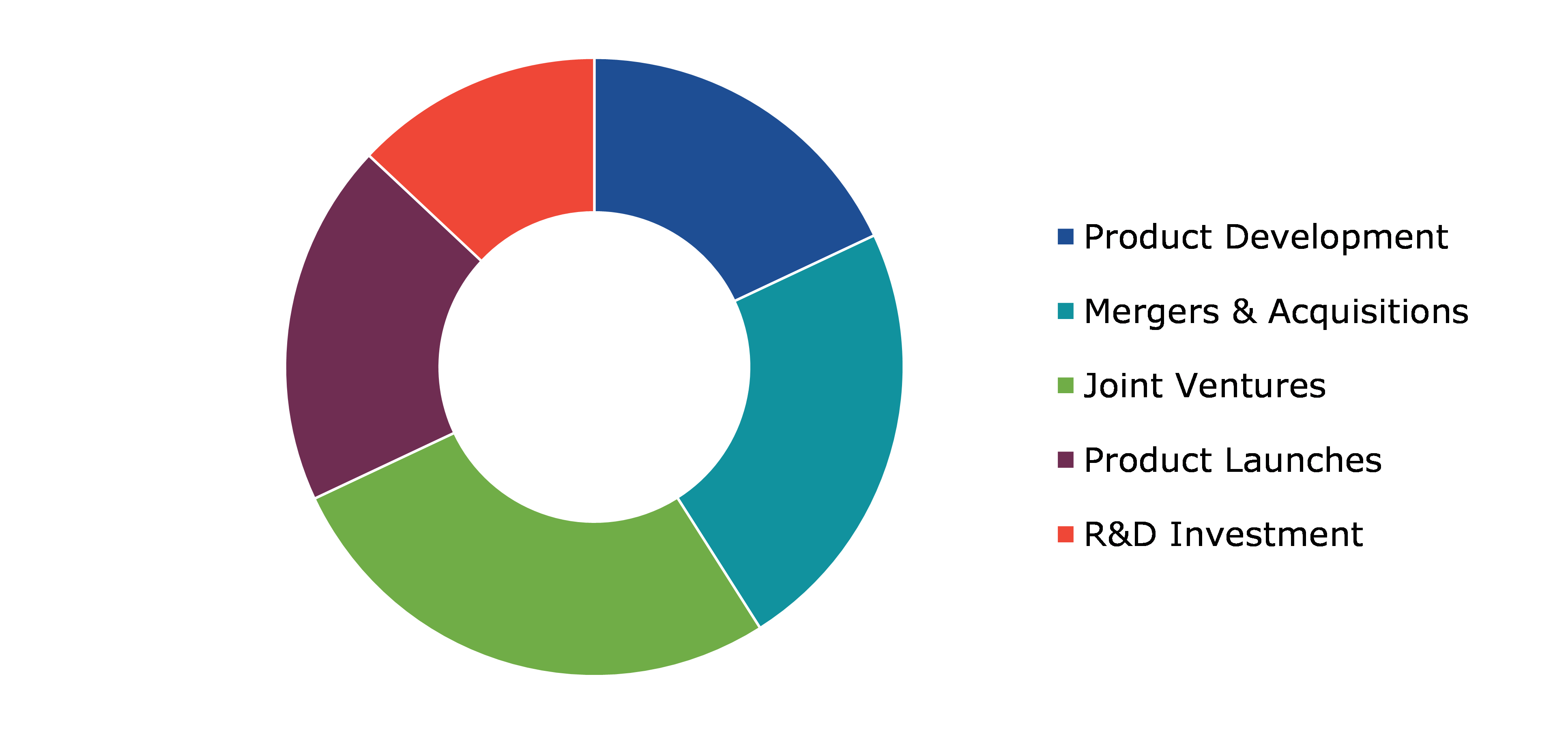Control Towers Market Report
RA08491
Control Towers Market by Type (Operational and Analytical), Application (Supply Chain and Transportation), End-use (Aerospace & Defense, Healthcare, Retail & Consumer Goods, Automotive & Manufacturing, Information & Technology, and Others), and Regional Analysis (North America, Europe, Asia-Pacific, and LAMEA): Global Opportunity Analysis and Industry Forecast, 2022–2030
Global Control Towers Market Analysis
The global control towers market size was $5,585 million in 2021 and is predicted to grow with a CAGR of 18.7%, by generating a revenue of $26,279.8 million by 2030.
Global Control Towers Market Synopsis
Control towers provide real-time, end-to-end visibility over a company's complete network, including its partners in industry and suppliers. Organizations have been pushed to adapt in today's competitive marketplace as a result of the growth of information technology, increased customer expectations, and globalization. Supply chain experts are having trouble managing the massive amounts of data in the present competitive market in order to create an integrated, efficient, and agile supply chain. Therefore, there is a need to build technologies that can quickly and intelligently evaluate enormous volumes of data due to the tremendous development in volume and variety of data. The use of Big Data Analytics (BDA) is one of the greatest methods for assisting enterprises in solving their issues. Big data analytics is a method for identifying important patterns and data in massive datasets. Real-time updates of supply chain activity, the use of real-time analytics to identify potential supply chain alignment and disruptions among organizations making up supply chains, and the development of centralized decision-making that focuses on meeting the needs of end-user customers through the capture and availability of pertinent data are all made possible by the availability of big data analytics, real-time analytics, and advanced technology.
However, some of the disadvantages of adopting the control tower includes security of data against data breach. In the age of big data, it is difficult for businesses to safeguard data against information leaks. Managing and analyzing massive volumes of data gives businesses a huge competitive advantage as it becomes one of the most essential components of a firm. However, it also exposes critical and priceless organizational data to loss or theft, causing serious security difficulties for businesses. Internet thieves, unauthorized users, and hackers might attempt to obtain this data, which could be harmful to the business.
Control towers market share is expected to increase due to the rising demand to improve operational and supply chain efficiency as globalization and competition increases. Global supply and demand markets are undergoing rapid change, and these changes are resulting in relationships that make it necessary to optimize the production and distribution of goods throughout an ecosystem and to have visibility into every activity taking place inside it. When installed appropriately, a control tower will give early notice of supply or demand imbalances, delayed shipments, and even anticipated stock outs. When the control tower is built with collaborative execution in mind, the user's organization can quickly identify exceptions and take corrective action in the same environment. Additionally, these solutions support businesses in identifying business expansion prospects and the expanding use of cutting-edge technologies such as AI, cloud computing, and IoT across a variety of industries, all of which are anticipated to increase the control tower market opportunity over the forecasted time period.
Control Towers Market Overview
Control tower is defined as personalized dashboard of data, connected, important business KPIs, and events occurring along the supply chain. A supply chain control tower enables businesses to better identify, classify, and address urgent problems in real time. Control towers are usually configured to observe, quantify, and control inventory and transportation movements the entire supply chain. Control tower combine organizations, using systems and procedures to give your supply chain partners a high level of product visibility along the full chain of supply.
COVID-19 Impact on Global Control Towers Market
The COVID-19 pandemic has brought about a number of concerns that have resulted in significant economic losses as many enterprises around the world came to a standstill. The epidemic caused supply chain disruptions that affected everyone in some way, including a lack of grocery products on store shelves and a shortage of masks and medical supplies. On the other hand, COVID-19 Impact on Control Towers Market is expected to have a negative immediate impact on the control towers market. Due to the outbreak, certain businesses in the manufacturing sector have been compelled to temporarily halt operations in order to adhere to new regulatory requirements. As a result of the pandemic, revenue streams have been directly impacted since supply chain and trade interruptions have negatively impacted overall operations. Disruptions in the supply chain have particularly negative effects on developing nations. With the widespread spread of COVID-19, countries all over the world are battling to combat the pandemic's threatening effects on the economy and regional stability. The significant impact on the economy is already evidence of the substantial effects of the coronavirus outbreak. Due to the disruptions in the global supply chain and regular operations, some important sectors, including electronics, vehicles, entertainment, transportation, tourism, and exports, are in severe trouble. Advanced control towers are now a must in the dynamic supply chain environment. They help businesses become more visible, make better decisions, and quickly identify and address supply chain problems.
Growing Adoption of Big Data Analysis, Real-Time Analytics, and Cognitive Technologies Projected to Drive the Market Growth
The demand for improved logistics and supply chain management procedures has become unavoidable with the globalization of the entire economy. Any supply management program's ability to acquire, organize, and analyze data is a key component of its success. Control tower solutions are in high demand from businesses in numerous industry sectors and are increasing speed. Numerous advantages provided by these technologies, such as precise forecasting and Business Intelligence (BI), aid in supply chain optimization, reduce waste, and boost organizational revenues. Businesses are attempting to function more effectively and efficiently across numerous industries while collaborating with numerous partners by using automated procedures to communicate information, analyze and filter out consumer feedback, and operate in these areas. Predictive analytics programmed and new big data science methodologies have been created in order to manage these brand-new, potentially priceless data sets. Conceptually speaking, there are numerous ways to use big data in logistics and supply chains to enhance procurement strategy. Big data improves supplier networks' data precision, transparency, and perspective, which helps supply chains share more complex information. These factors are anticipated to boost the control towers market growth in forecasted time period.
Data Security Concerns among Enterprises can Restrain the Market Growth
The main factor that can restrain the business from using control tower is data security. The likelihood of a cyberattack occurring is significantly increased by inadequate or absent security measures. An organization is the subject of a supply chain attack, which involves penetration or attack via a third-party provider. One of these organizations may end up serving as the point of entry for the whole supply chain if it has weak Cyber Security threat protection. The danger surface of a corporation might be extremely complex due to the wide range of risk. An organization may suffer significant harm from cyberattacks and data breaches in the form of brand damage, cleanup expenses, lost revenue, and other factors. Different cloud-based platforms may or may not be able to guarantee data security and prevent unwanted access to critical information. Internet thieves, unauthorized users, and hackers might attempt to obtain this data, which could be harmful to the business.
Rise in the Need for Enhancing Operational and Supply Chain Efficiencies might create the Growth Opportunities
Any organization that maintains inefficient and unproductive business procedures in a highly competitive environment incurs a significant opportunity cost. Organizations have to invest in process improvement approaches such as Internet of Things (IoT), machine learning, reengineering, operational enhancing, and others, to overcome these inefficiencies and improve service quality. Control tower adds value to supply chain management by enhancing the operational capability and efficiency through use of technology such as big data analytics and artificial intelligence. The AI-driven technologies in a control tower can aggregate data instantly, but they can also link and increase data through real-time data processing and predictive analytics. Better decision-making across the entire supply chain is made possible by these talents, which reduces costs, increases productivity, and reduces waste.
Big data is a control tower's main source of revenue and encompasses every aspect of the transportation sector, from inventory levels and on-time deliveries to supply chain interruptions and exception management. Control towers offer enhanced visibility and cutting-edge data when you need it most, advising and directing stakeholders along the supply chain with the aid of potent machine learning procedures. Trends in the control towers market include a growth in online commerce, a desire for real-time monitoring, and a surge in smartphone usage in developing countries. Control towers market trends include the increase in online shopping, desire for real-time monitoring, and rising use of smartphones in emerging nations are generating opportunity for control tower.
Global Control Towers Market, by Type
Based on type, the market has been divided into operational and analytical. The operational sub-segment accounted for the highest revenue share in 2021, and the analytical sub-segment is predicted to show the fastest growth during the forecast period.
Global Control Towers Market Share, by Type, 2021
Source: Research Dive Analysis
The operational sub-segment is anticipated to show the dominated market share and generate a revenue of $20,721.9 million by 2030, increasing from $4,498.2 million in 2021. Control towers of this kind are employed for both analysis and action. This will be an all-inclusive solution that offers all required features. Larger systems with analytical capability include operational control towers. Within the supply chain control tower, deals are made. The control tower system is used by all trading partners in the supply chain to manage their daily supply chain execution activities. This enriches the platform's data so that useful analysis may be done inside the supply chain control tower as well. Based on the analysis, any necessary corrective measures are carried out inside the control tower system. For instance, if the supplier did not provide an advance shipment notice, corrective action would be to send the shipment notification.
The analytical sub-segment is anticipated to show the fastest growth and generate a revenue of $5,557.9 million by 2030, increasing from $1,086.8 million in 2021. Real-time analytics can give the analytical control tower vital information. It can assist in organizing and monitoring decisions and execution across functions and companies to optimize the network as a whole. The need for a consistent cost-saving solution and the growing size of data in supply chains are anticipated to drive demand for analytical control tower across industry verticals.
Global Control Towers Market, by Application
Based on application, the analysis has been divided into supply chain and transportation. Out of these, the supply chain sub-segment is predicted to be the most dominant and is anticipated to show the fastest growth during the forecast period.
Global Control Towers Market Share, by Application, 2021
Source: Research Dive Analysis
The supply chain sub-segment is anticipated to have a dominant market share and generate a revenue of $14,756.5 million by 2030, growing from $3,068.2 million in 2021. Control towers offer centralized data solutions, factual information, which is utilized to increase visibility in supply chains. The status of an order, the logistical costs of a product, the performance of a supply chain partner, root cause analysis are just a few examples of the timely and factual information that complex supply chains require. Control towers with centralized data solutions are made to supply such information in order to give prompt, comprehensive solution to such problems faced by supply chain. Control tower advantages mostly stem from improved supply chain visibility. Better planning, more informed decision-making, proactive event management, enhanced performance of supply chain partners, and more advanced supply chain analytics are all made possible by them. The use of control tower in supply chain helps to reduce logistics expenses, lower inventory and increase total cycle time.
Global Control Towers Market, by End-use
Based on end-use, the analysis has been divided into aerospace & defense, chemicals, retail and consumer goods, healthcare and pharmaceutical, automotive & manufacturing, information and technology, and others. Among these, the automotive & manufacturing sub-segment accounted for highest revenue share in 2021.
Global Control Towers Market Share, by End-use, 2021
Source: Research Dive Analysis
The automotive & manufacturing sub-segment is anticipated to have a dominant market share and generate a revenue of $6207.4 million by 2030, growing from $1,428.9 million in 2021. The use of control tower in automotive & manufacturing sub-segment helps to gather organized and unstructured data from an organization's manufacturing lines, tools, and facilities. It makes it easier to create virtual dashboards that offer important details on the performance and status of manufacturing processes, as well as their dependence on suppliers of raw materials, which in turn has an impact on order fulfilment, and transportation. Decision-makers can gain insights that were previously unavailable to them when they have access to real-time manufacturing data that has been compiled from across the business. The use of control tower in automotive & manufacturing sectors results in improved KPIs, such as increased throughput, decreased scrap, and quicker batch cycle times, which all contribute to improved performance.
Global Control Towers Market, Regional Insights
The methanol market was investigated across North America, Europe, Asia-Pacific, and LAMEA.
Global Control Towers Market Size & Forecast, by Region, 2021-2030 (USD Million)
Source: Research Dive Analysis
The Market for Control Towers in North America to be the Most Dominant
The North America control towers market analysis accounted $2,822.1 million in 2021 and is projected to grow with a CAGR of 18.44%. The need for control towers has increased in North America due to a rise in the usage of transportation management systems and third-party logistics service providers to handle particular areas of a company's transportation and logistics network. Organizations in North America are increasingly adopting strategies to manage the enormous amounts of knowledge generated by value chains and use the data to generate business insights. As businesses look for ways to reduce costs and boost profitability, fierce competition and an increase in operating costs are also boosting the adoption of control towers in the organized retail sector in the region. Digitization and other cutting-edge technologies are being steadily embraced by organizations in the region. In order to create more customer-centric growth engines while being robust and responsible, North America is relying more and more on its supply chains. Opportunities for the control tower in the supply chain have been made possible by the development of new disruptive technologies and new business models.
Competitive Scenario in the Global Control Towers Market
Investment and agreement are common strategies followed by major market players. For instance, in April 2022, the leading information technology company Microsoft and Kraft Heinz entered into agreement to build control tower to address the supply chain disruption of the company.
Source: Research Dive Analysis
Some of the leading control towers market players are Blue Yonder Group, E2open, INFOR, KINAXIS, SAP SE, DiLX, o9 solutions, ORTEC, Viewlocity Technologies Pty Ltd, and One Network Enterprises.
| Aspect | Particulars |
| Historical Market Estimations | 2020-2021 |
| Base Year for Market Estimation | 2021 |
| Forecast Timeline for Market Projection | 2022-2030 |
| Geographical Scope | North America, Europe, Asia-Pacific, LAMEA |
| Segmentation by Type |
|
| Segmentation by Application |
|
| Segmentation by End-use |
|
| Key Companies Profiled |
|
Q1. What is the size of the global control towers market?
A. The size of the global control tower market was over $5,585 million in 2021 and is projected to reach $26,279.8 million by 2030.
Q2. Which are the major companies in the control towers market?
A. E2open, INFOR, and KINAXIS are some of the key players in the global control towers market.
Q3. Which region, among others, possesses greater investment opportunities in the near future for Control Towers Market?
A. The Asia-Pacific region possesses great investment opportunities for investors to witness the most promising growth in the future.
Q4. What will be the growth rate of the Asia-Pacific control towers market?
A. Asia-Pacific control towers market is anticipated to grow at 19.21% CAGR during the forecast period.
Q5. What are the strategies opted by the leading players in this Control Tower market?
A. Agreement and investment are the two key strategies opted by the operating companies in this market.
Q6. Which companies are investing more on R&D practices for Control Towers Market?
A. SAP SE, DiLX, and o9 solutions are the companies investing more on R&D activities for developing new products and technologies.
1.Research Methodology
1.1.Desk Research
1.2.Real time insights and validation
1.3.Forecast model
1.4.Assumptions and forecast parameters
1.5.Market size estimation
1.5.1.Top-down approach
1.5.2.Bottom-up approach
2.Report Scope
2.1.Market definition
2.2.Key objectives of the study
2.3.Report overview
2.4.Market segmentation
2.5.Overview of the impact of COVID-19 on Global control towers market
3.Executive Summary
4.Market Overview
4.1.Introduction
4.2.Growth impact forces
4.2.1.Drivers
4.2.2.Restraints
4.2.3.Opportunities
4.3.Market value chain analysis
4.3.1.List of raw material suppliers
4.3.2.List of manufacturers
4.3.3.List of distributors
4.4.Innovation & sustainability matrices
4.4.1.Technology matrix
4.4.2.Regulatory matrix
4.5.Porter’s five forces analysis
4.5.1.Bargaining power of suppliers
4.5.2.Bargaining power of consumers
4.5.3.Threat of substitutes
4.5.4.Threat of new entrants
4.5.5.Competitive rivalry intensity
4.6.PESTLE analysis
4.6.1.Political
4.6.2.Economical
4.6.3.Social
4.6.4.Technological
4.6.5.Environmental
4.7.Impact of COVID-19 on control towers market
4.7.1.Pre-covid market scenario
4.7.2.Post-covid market scenario
5.Control Towers Market Analysis, by Type
5.1.Overview
5.2.Operational
5.2.1.Definition, key trends, growth factors, and opportunities
5.2.2.Market size analysis, by region,2021-2030
5.2.3.Market share analysis, by country,2021-2030
5.3.Analytical
5.3.1.Definition, key trends, growth factors, and opportunities
5.3.2.Market size analysis, by region,2021-2030
5.3.3.Market share analysis, by country,2021-2030
5.4.Research Dive Exclusive Insights
5.4.1.Market attractiveness
5.4.2.Competition heatmap
6.Control Towers Market Analysis, by Application
6.1.Overview
6.2.Supply Chain
6.2.1.Definition, key trends, growth factors, and opportunities
6.2.2.Market size analysis, by region,2021-2030
6.2.3.Market share analysis, by country,2021-2030
6.3.Transportation
6.3.1.Definition, key trends, growth factors, and opportunities
6.3.2.Market size analysis, by region,2021-2030
6.3.3.Market share analysis, by country,2021-2030
6.4.Research Dive Exclusive Insights
6.4.1.Market attractiveness
7.Competition heatmap
8.Control Towers Market Analysis, by End-use
8.1.Aerospace & Defense
8.1.1.Definition, key trends, growth factors, and opportunities
8.1.2.Market size analysis, by region,2021-2030
8.1.3.Market share analysis, by country,2021-2030
8.2.Healthcare
8.2.1.Definition, key trends, growth factors, and opportunities
8.2.2.Market size analysis, by region,2021-2030
8.2.3.Market share analysis, by country,2021-2030
8.3.Retail & Consumer Goods
8.3.1.Definition, key trends, growth factors, and opportunities
8.3.2.Market size analysis, by region,2021-2030
8.3.3.Market share analysis, by country,2021-2030
8.4.Automotive & Manufacturing
8.4.1.Definition, key trends, growth factors, and opportunities
8.4.2.Market size analysis, by region,2021-2030
8.4.3.Market share analysis, by country,2021-2030
8.5.Information & Technology
8.5.1.Definition, key trends, growth factors, and opportunities
8.5.2.Market size analysis, by region,2021-2030
8.5.3.Market share analysis, by country,2021-2030
8.6.Others
8.6.1.Definition, key trends, growth factors, and opportunities
8.6.2.Market size analysis, by region,2021-2030
8.6.3.Market share analysis, by country,2021-2030
8.7.Research Dive Exclusive Insights
8.7.1.Market attractiveness
8.7.2.Competition heatmap
9.Control Towers Market, by Region
9.1.North America
9.1.1.U.S.
9.1.1.1.Market size analysis, by Type,2021-2030
9.1.1.2.Market size analysis, by Application,2021-2030
9.1.1.3.Market size analysis, by End-use,2021-2030
9.1.2.Canada
9.1.2.1.Market size analysis, by Type,2021-2030
9.1.2.2.Market size analysis, by Application,2021-2030
9.1.2.3.Market size analysis, by End-use,2021-2030
9.1.3.Mexico
9.1.3.1.Market size analysis, by Type,2021-2030
9.1.3.2.Market size analysis, by Application,2021-2030
9.1.3.3.Market size analysis, by End-use,2021-2030
9.1.4.Research Dive Exclusive Insights
9.1.4.1.Market attractiveness
9.1.4.2.Competition heatmap
9.2.Europe
9.2.1.Germany
9.2.1.1.Market size analysis, by Type,2021-2030
9.2.1.2.Market size analysis, by Application,2021-2030
9.2.1.3.Market size analysis, by End-use,2021-2030
9.2.2.UK
9.2.2.1.Market size analysis, by Type,2021-2030
9.2.2.2.Market size analysis, by Application,2021-2030
9.2.2.3.Market size analysis, by End-use,2021-2030
9.2.3.France
9.2.3.1.Market size analysis, by Type,2021-2030
9.2.3.2.Market size analysis, by Application,2021-2030
9.2.3.3.Market size analysis, by End-use,2021-2030
9.2.4.Spain
9.2.4.1.Market size analysis, by Type,2021-2030
9.2.4.2.Market size analysis, by Application,2021-2030
9.2.4.3.Market size analysis, by End-use,2021-2030
9.2.5.Italy
9.2.5.1.Market size analysis, by Type,2021-2030
9.2.5.2.Market size analysis, by Application,2021-2030
9.2.5.3.Market size analysis, by End-use,2021-2030
9.2.6.Rest of Europe
9.2.6.1.Market size analysis, by Type,2021-2030
9.2.6.2.Market size analysis, by Application,2021-2030
9.2.6.3.Market size analysis, by End-use,2021-2030
9.2.7.Research Dive Exclusive Insights
9.2.7.1.Market attractiveness
9.2.7.2.Competition heatmap
9.3.Asia-Pacific
9.3.1.China
9.3.1.1.Market size analysis, by Type,2021-2030
9.3.1.2.Market size analysis, by Application,2021-2030
9.3.1.3.Market size analysis, by End-use,2021-2030
9.3.2.Japan
9.3.2.1.Market size analysis, by Type,2021-2030
9.3.2.2.Market size analysis, by Application,2021-2030
9.3.2.3.Market size analysis, by End-use,2021-2030
9.3.3.India
9.3.3.1.Market size analysis, by Type,2021-2030
9.3.3.2.Market size analysis, by Application,2021-2030
9.3.3.3.Market size analysis, by End-use,2021-2030
9.3.4.Australia
9.3.4.1.Market size analysis, by Type,2021-2030
9.3.4.2.Market size analysis, by Application,2021-2030
9.3.4.3.Market size analysis, by End-use,2021-2030
9.3.5.South Korea
9.3.5.1.Market size analysis, by Type,2021-2030
9.3.5.2.Market size analysis, by Application,2021-2030
9.3.5.3.Market size analysis, by End-use,2021-2030
9.3.6.Rest of Asia-Pacific
9.3.6.1.Market size analysis, by Type,2021-2030
9.3.6.2.Market size analysis, by Application,2021-2030
9.3.6.3.Market size analysis, by End-use,2021-2030
9.3.7.Research Dive Exclusive Insights
9.3.7.1.Market attractiveness
9.3.7.2.Competition heatmap
9.4.LAMEA
9.4.1.Brazil
9.4.1.1.Market size analysis, by Type,2021-2030
9.4.1.2.Market size analysis, by Application,2021-2030
9.4.1.3.Market size analysis, by End-use,2021-2030
9.4.2.Saudi Arabia
9.4.2.1.Market size analysis, by Type,2021-2030
9.4.2.2.Market size analysis, by Application,2021-2030
9.4.2.3.Market size analysis, by End-use,2021-2030
9.4.3.UAE
9.4.3.1.Market size analysis, by Type,2021-2030
9.4.3.2.Market size analysis, by Application,2021-2030
9.4.3.3.Market size analysis, by End-use,2021-2030
9.4.4.South Africa
9.4.4.1.Market size analysis, by Type,2021-2030
9.4.4.2.Market size analysis, by Application,2021-2030
9.4.4.3.Market size analysis, by End-use,2021-2030
9.4.5.Rest of LAMEA
9.4.5.1.Market size analysis, by Type,2021-2030
9.4.5.2.Market size analysis, by Application,2021-2030
9.4.5.3.Market size analysis, by End-use,2021-2030
9.4.6.Research Dive Exclusive Insights
9.4.6.1.Market attractiveness
9.4.6.2.Competition heatmap
10.Competitive Landscape
10.1.Top winning strategies, 2021
10.1.1.By strategy
10.1.2.By year
10.2.Strategic overview
10.3.Market share analysis, 2021
11.Company Profiles
11.1.Blue Yonder Group
11.1.1.Overview
11.1.2.Business segments
11.1.3.Product portfolio
11.1.4.Financial performance
11.1.5.Recent developments
11.1.6.SWOT analysis
11.2.E2open
11.2.1.Overview
11.2.2.Business segments
11.2.3.Product portfolio
11.2.4.Financial performance
11.2.5.Recent developments
11.2.6.SWOT analysis
11.3.INFOR
11.3.1.Overview
11.3.2.Business segments
11.3.3.Product portfolio
11.3.4.Financial performance
11.3.5.Recent developments
11.3.6.SWOT analysis
11.4.KINAXIS
11.4.1.Overview
11.4.2.Business segments
11.4.3.Product portfolio
11.4.4.Financial performance
11.4.5.Recent developments
11.4.6.SWOT analysis
11.5.SAP SE
11.5.1.Overview
11.5.2.Business segments
11.5.3.Product portfolio
11.5.4.Financial performance
11.5.5.Recent developments
11.5.6.SWOT analysis
11.6.DiLX
11.6.1.Overview
11.6.2.Business segments
11.6.3.Product portfolio
11.6.4.Financial performance
11.6.5.Recent developments
11.6.6.SWOT analysis
11.7.o9 solutions
11.7.1.Overview
11.7.2.Business segments
11.7.3.Product portfolio
11.7.4.Financial performance
11.7.5.Recent developments
11.7.6.SWOT analysis
11.8.ORTEC
11.8.1.Overview
11.8.2.Business segments
11.8.3.Product portfolio
11.8.4.Financial performance
11.8.5.Recent developments
11.8.6.SWOT analysis
11.9.Viewlocity Technologies Pty Ltd
11.9.1.Overview
11.9.2.Business segments
11.9.3.Product portfolio
11.9.4.Financial performance
11.9.5.Recent developments
11.9.6.SWOT analysis
11.10.One Network Enterprises
11.10.1.Overview
11.10.2.Business segments
11.10.3.Product portfolio
11.10.4.Financial performance
11.10.5.Recent developments
11.10.6.SWOT analysis
12.Appendix
12.1.Parent & peer market analysis
12.2.Premium insights from industry experts
12.3.Related reports
A control tower is a hub used for action, visibility, and decision-making based on real-time analytics. The use of a control tower is becoming more common across the globe as a way to implement comprehensive solutions, deal with uncertainty, and balance services, prices, and consumer expectations. The rising demand for control towers from the transportation & supply chain ecosystem makes the delivery process easier and more efficient to track deliveries in real-time. This is the major factor likely to bolster the growth of the control towers market around the world. Further, the growing demand for analytical tower solutions and the increasing volume of data across supply chains are other factors expected to drive the market growth in the coming years.
COVID-19 Impact on Control Towers Market
The outbreak of COVID-19 across the globe has had a short-term adverse impact on the global control towers market growth. This is mainly because some of the manufacturing enterprises in the market temporarily suspended their operations to comply with new regulatory restrictions. Restrictions on transportation, stringent border controls, and limited accessibility to air transportation are delaying the procurement of components and raw materials, along with product shipments to customers.
The pandemic has directly affected the revenue streams and overall operations due to trade and supply chain disruptions. Due to this, the demand and production schedules are at risk and are therefore posing financial threats to firms and financial markets. However, the pandemic is also acting as a catalyst for the development of better production and distribution networks in order to better cater to the global demand. Companies across the globe are now focusing on the adopting advanced control towers to better predict, respond, and forecast supply chain issues.
Control Towers Market Trends and Developments
The companies operating in the global industry are adopting various growth strategies and business tactics such as partnerships, acquisitions, business expansion, and product launches to obtain a leading position in the global industry, which is predicted to drive the global control towers market growth in the upcoming years.
- In June 2019, Amazon Web Services Inc. announced the launch and availability of ‘AWS Control Tower,’ a service for customers that makes it easy for them to set up and constantly govern secure, compliant multi-account AWS environments. According to the company, AWS Control Tower is easy to use for customers with the AWS Management Console in order to organize their new multi-account environment.
- In April 2020, One Network Enterprises, an intelligent business platform for autonomous supply chain management, declared the availability of Telematics-enabled Control Tower Solution coupled with real-time tracking thru its Telematics Network. The solution comprises of pre-integrated connections to telematics services and thus makes it easy for global carriers, freight forwarders, and other logistics service providers easy to collaborate with shipping partners.
- In February 2021, cloudtamer.io, a leading provider of multi-cloud governance solution, announced a new integration with AWS Control Tower to provide cost management features that balance AWS Control Tower and also help in restructuring spend management for customers at scale.
Forecast Analysis of the Global Market
The global control towers market is projected to witness an exponential growth during the forecast period, owing to the growing need for businesses to enhance operational and supply chain efficiencies. Conversely, the increasing data security concerns and the various issues encountered by enterprises after adopting control towers are the factors expected to hamper the market growth in the projected timeframe.
The increasing adoption of big data analysis, cognitive technologies, and real-time analytics by various organizations across the globe are the significant factors and control towers market trends estimated to bolster the growth of the global market in the coming future. According to a latest report published by Research Dive, the global control towers market is expected to garner $26,279.8 million during the forecast period (2022-2030). Regionally, the North America region is estimated to hold the majority of market share over the forecast period mainly owing to the new disruptive technologies, presence of significant market players, and the emergence of new business models in the region. The key players functioning in the global market include Blue Yonder Group, E2open, INFOR, KINAXIS, SAP SE, DiLX, o9 solutions, ORTEC, Viewlocity Technologies Pty Ltd, and One Network Enterprises.
Personalize this research
- Triangulate with your own data
- Request your format and definition
- Get a deeper dive on a specific application, geography, customer or competitor
- + 1-888-961-4454 Toll - Free
- support@researchdive.com

